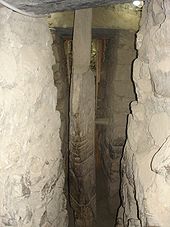Chavín de Huantar
Chavín de Huántar is an archaeological site in Peru that has only been explored up to 15 percent. She gave the name to a culture that developed between 850 BC. Until 200 BC BC, but never formed a geographical center. It is much more likely that this place was at the intersection between the connection from the mountains to the coast and the route from north to south. The site is a 2-hour drive from the city of Huaraz , capital of the Ancash region , about 500 km northeast of Lima . The culture spread both in the highlands and along the coastal area and has influenced many of the cultures that followed.
Purpose of the site
What Chavín actually was is still unknown today. It is believed that it was in bloom between 400 and 200 BC. It was an oracle and cult center of a more significant dimension, whose cultural activity was textile and ceramic production as well as metalworking . The Chavín complex is considered to be the oldest ensemble of stone structures in Peru. The granite blocks come from the Kahuish Pass and were floated in during the rainy season .
Construction
The facility comprises several buildings with various platforms and inner courtyards, some of which are connected to one another by underground passages. The main structures are an "Old Temple" and a "New Temple" as well as a building erroneously called "Castillo" by the Spaniards , a three-story, square pyramid with a side length of 70 m and a height of about 15 m. The side walls are inclined at 7 degrees to protect against earthquakes . Inside there is a labyrinth of small chambers, stairs and ramps that are connected by underground passages and have horizontal ventilation channels. The walls were decorated with stone heads, some of which are well preserved or restored. Archaeologists believe that they are depictions of victims or captured enemies. The stone reliefs show big cats (possibly jaguars ) in connection with snakes and condors .

In the center of the building is the 4.5 m high monolith "El Lanzón", a human-shaped image of God with claws on hands and feet, which is located at the intersection of cross-shaped galleries. The figure in the shape of a knife with the handle upwards shows the face of a predator with numerous snakes between its teeth. Snakes hang from the ends of the hair and even from the belt. The monolith is the oldest figure found in this area. The Raimondi stele and the Tello obelisk, which are now in the Archaeological Museum in Lima, are much younger . However, the motifs shown on it are similar. Julio Tello , a Peruvian archaeologist, came to the view that Chavín united different cultures up to the Incas in one religious ideology .
This culture knew simple techniques for working gold . Snake-shaped pieces of jewelry and gold plates in the form of stylized big cat motifs were found. Ceramics and textile products also feature predator motifs.
Similar motifs were found in the subsequent Moche culture , but also in the area around Tiahuanaco .
In 1985 UNESCO declared Chavín a UNESCO World Heritage Site .
literature
- Peter Fux (ed.): Chavín: Peru's mysterious Andean temple . Catalog of an exhibition in the Museum Rietberg Zurich, November 23, 2012 - March 10, 2013. Museum Rietberg Zurich and Scheidegger & Spiess, Zurich 2012, ISBN 978-3-85881-365-7 .
- Harald Haarmann : Lexicon of the lost peoples - from Akkadians to Zimbri. Beck, Munich 2005, ISBN 3-406-52817-1 . Pp. 81-82.
- Richard L. Burger: The prehistoric occupation of Chavin de Huántar, Peru. Univ. of California Press, Berkeley 1984, ISBN 0-520-09667-3 .
- Richard L. Burger: Chavín de Huántar and Its Sphere of Influence. In: Helaine Silverman, William H. Isbell: Handbook of South American archeology. Springer, New York 2008, ISBN 978-0-387-74906-8 . Pp. 681-701.
- Peter N. Peregrine: Encyclopedia of prehistory - South America. Kluwer Academic Publ., New York 2002, ISBN 0-306-46261-3 . Pp. 38-57.
- Christopher B. Donnan: Early Ceremonial Architecture in the Andes. Dumbarton, Washington 1985, ISBN 0-88402-135-1 .
- Karen Olsen Bruhns: The First Civilizations: 2000-200 BC. In: Ancient South America. Cambridge Univ. Press, Cambridge 1994, ISBN 0-521-27761-2 . Pp. 126-155.
- Chris Scarre : The Seventy Wonders of the World: The Most Mysterious Structures of Mankind and How They Were Built . Frederking & Thaler, Munich, 3rd edition, 2006, ISBN 3-89405-524-3 .
- Huantar San Marcos. Sitios Arqueologicos en la Sierra de Ancash. Instituto Cultural RVNA, Lima (Peru), 2005, ISBN 9972-9694-2-8 (Spanish).
- Entry on the UNESCO World Heritage Center website ( English and French ).
Movies
- José María Morales: Temple of Human Sacrifice: Chavín de Huántar . Spain 2016, for ZDF .
Web links
- Louis Gerber: Chavin: Peru's mysterious Andean temple. The exhibition in the Museum Rietberg in Zurich and the accompanying catalog. In: cosmopolis.ch. March 1, 2013 (review).
Individual evidence
- ↑ Scarre: The Seventy Wonders of the World .
Coordinates: 9 ° 35 ′ 38 ″ S , 77 ° 10 ′ 40 ″ W

